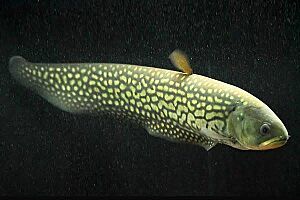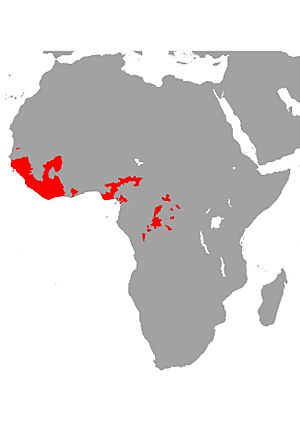Papyrocranus afer facts for kids
Quick facts for kids Papyrocranus afer |
|
|---|---|
 |
|
| Reticulated knifefish | |
| Conservation status | |
| Scientific classification | |
 |
The reticulated knifefish (Papyrocranus afer) is a cool freshwater fish. It belongs to the family called Notopteridae, also known as featherbacks. You can find this fish in the tropical parts of West Africa. It can grow quite big, reaching up to 80 centimeters (31 inches) long. Some have even weighed about 1.3 kilograms (2.9 pounds)!
Contents
What Does the Reticulated Knifefish Look Like?
This fish usually grows to about 62 centimeters (24 inches) long. Its body is flat from side to side, like a knife blade. This is why it's called a "knifefish"! It has very small scales.
Like other featherback fish, it has a special fin on its back called the dorsal fin. This fin looks a bit like a feather. It doesn't have any sharp spines, only two soft rays. The reticulated knifefish also has a very long fin on its belly, called the anal fin. This fin has no spines and many soft rays, between 113 and 141. This long fin connects to its small tail fin. Interestingly, this fish does not have pelvic fins. The anal fin helps the fish move. It ripples from side to side, allowing the fish to swim forwards or even backwards!
Where Does the Reticulated Knifefish Live?
This fish is native to the warm areas of West Africa. You can find it in the Niger River basin. It also lives in other rivers near the coast. These include the Tano River and Pra River basins in Ghana. Further east, it lives in the Cross River and Sanaga River basins, which are near the Niger Delta.
Amazing Abilities of the Reticulated Knifefish
How Does It Breathe?
Besides breathing in the normal way with its gills, the reticulated knifefish can also breathe air! It comes to the surface of the water to do this. For air breathing, it uses its swim bladder. This is a long organ inside its body that acts like a lung. It has small, finger-like parts on its sides. This special ability helps the fish live in swamps. In swamps, the water often has very little oxygen. Being able to breathe air helps the fish survive in these tough places. The swim bladder can also be used to make sounds!
Reproduction and Life Cycle
The reticulated knifefish lays a small number of eggs, but these eggs are quite large. On average, a fish lays about 500 eggs for every kilogram of its body weight. Each egg is about 3.6 millimeters (0.14 inches) wide. Because the eggs are large, the baby fish (larvae) that hatch are also big. This gives them a better chance of surviving in places where it might be hard to live.
Special Senses: Electroreception
The reticulated knifefish is part of a small group of fish called teleost fish that can sense electricity. This ability is called electroreception. Even though the fish doesn't make its own electricity, it is very good at feeling electric charges around it. It uses this special sense to find things nearby. It can detect its prey and also avoid predators by sensing their electric fields.


